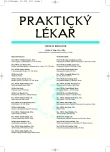Diagnostic problems of non-alcoholic steatohepatitis in clinicopathological practice
Authors:
V. Bartoš 1; P. Slávik 2; D. Krkoška 3
Authors‘ workplace:
Ústav histológie a embryológie JLF UK v Martine
Vedúci: doc. MUDr. Adamkov M. CSc.
; Ústav patologickej anatómie JLF UK a MFN v Martine
Vedúci: prof. MUDr. Plank L. CSc.
2; Klinika infektológie a cestovnej medicíny JLF UK a MFN v Martine
Vedúci: prof. MUDr. Szilágyiová M. CSc.
3
Published in:
Prakt. Lék. 2008; 88(1): 14-17
Category:
Reviews
Overview
Non-alcoholic fatty liver disease (NAFLD) has recently become one of the most frequent and most important hepatic disorders throughout the world. This complex clinicopathological condition includes a spectrum of several nosological entities with distinct prognosis. The mildest form is a simple steatosis that can progress to steatohepatitis, steatofibrosis and can ultimately lead to cirrhosis or hepatocellular carcinoma. Although simple fatty liver is a relatively benign condition, non-alcoholic steatohepatitis (NASH) is much more dangerous and may have a very poor or unpredictable outcome. Furthermore, NAFLD is commonly without clinical manifestation and often discovered through incidentally elevated hepatic enzyme levels. Because it is an exclusion diagnosis, establishing of NASH can be difficult in clinical practice. It depends in great part on the veracity of the patient and his statement denying significant alcohol consumption. Liver biopsy is considered to be a “gold standard” diagnostic process, because it is of unquestioned value in determining the presence of steatosis or steatohepatitis. Fatty changes in liver parenchyma can be also detected by noninvasive imaging methods, however, microscopical examination is the only relatively reliable one to assess the morphological severity of this disease, and thus estimate a further prognosis. None of the clinical examinations has sufficient sensitivity and specificity for histological grading and staging of NAFLD, and cannot distinguish between simple steatosis and NASH with or without fibrosis. In addition to establishing the severity, histology permits the monitoring of disease progression and the response to therapy, as aminotransaminase levels may decrease during the course of the disease regardless of whether fibrosis progresses or improves. Finally, further studies on the pathogenesis of NASH may improve our understanding of the mechanisms involved in NAFLD progression, but may also lead to potentially novel therapeutic strategies to treat this frequent condition.
Key words:
non-alcoholic fatty liver disease, non-alcoholic steatohepatitis.
Sources
1. Brunt, E.M., Janney, C.G., Di Bisceglie, A.M. et al. Nonalcoholic steatohepatitis: a proposal for grading and staging the histological lesions. Am. J. Gastroenterol. 1999, 94, p. 2467-2474.
2. Gordon, A., McLean, C.A., Pedersen, J.S. et al. Hepatic steatosis in chronic hepatitis B and C: predictors, distribution and effect on fibrosis. J. Hepatol. 2005, 43, p. 38-44.
3. Hübscher, G.S. Histological assessment of non-alcoholic fatty liver disease. Histopathology 2006, 49, p. 450-465.
4. Jarčušková, M., Pobeha, J. Nealkoholová steatóza pečene a metabolický syndróm. Slovenský lekár 2006, 1-2, 16, (30), s. 4-6.
5. Kleiner, D.E., Brunt, E.M., Van Natta, M. et al. Design and validation of a histological scoring system for nonalcoholic fatty liver disease. Hepatology 2005, 41, p. 1313-1321.
6. Kuchta, M., Nováková, B., Gombošová, K., Petrášová, M. Steatóza a obezita detí a dospievajúcich. Pediatria 2007, 2 (1), s. 18-22.
7. Ludwig, J., Viggiano, T.R., McGill, D.B. et al. Nonalcoholic steatohepatitis. Mayo Clinic experiences with a hitherto unnamed disease. Mayo Clin. Proc. 1980, 55, p. 434-438.
8. Marion, A.W., Baker, A.J., Dhawan, A. Fatty liver disease in children. Arch. Dis. Child 2004, 89, p. 648-652.
9. Mendler, M.H. Kanel, G., Govindarajan, S. Proposal for a histological scoring and grading system for non-alcoholic fatty liver disease. Liver Int. 2005, 25, p. 294-304.
10. Poonawala, A.Q., Nair, A.P., Thuuluvath, P.J. Prevalence of obesity and diabetes in patients with cryptogenic cirrhosis. A case-control study. Hepatology 2000,; 32, p. 689-692.
11. Saadeh, S., Younossi, Z.M., Remer, E.M. et al. The utility of radiological imaging in nonalcoholic fatty liver disease. Gastroenterology 2002, 123 (3), p. 745-750.
12. Schwimmer, J.B., Behling, C., Newbury, R. et al. Histopathology of pediatric nonalcoholic fatty liver disease. Hepatology 2005, 42, p. 641-649.
13. Struben, V.M., Hespenheide, E.E., Caldwell, S.H. Nonalcoholic steatohepatitsi and cryptogenic cirrhosis within kindreds. Am. J. Med. 2000, 108 (1), p. 9-13.
14. Šochman, J. Nemoc tučných jater a statiny – kterému oboru patří tento problém? Čas. lék. čes. 2006, 145, s. 443-446.
15. Younossi, Z.M., Gramlich, T., Liu, Y.C. et al. Nonalcoholic fatty liver disease: assessment of variability in pathologic interpretations. Mod. Pathol. 1998, 11, p. 560-565.
16. Zima, M. Nealkoholová steatohepatitída. Gastroenterol. prax. 2006,; 5 (1), p. 7-13.
Labels
Addictology Allergology and clinical immunology Anaesthesiology, Resuscitation and Inten Angiology Audiology Clinical biochemistry Dermatology & STDs Paediatric dermatology & STDs Paediatric gastroenterology Paediatric gynaecology Paediatric surgery Paediatric cardiology Paediatric neurology Paediatric clinical oncology Paediatric ENT Paediatric pneumology Paediatric psychiatry Paediatric radiology Paediatric urologist Diabetology Endocrinology Pharmacy Clinical pharmacology Physiotherapist, university degree Gastroenterology and hepatology Medical genetics Geriatrics Gynaecology and obstetrics Haematology Hygiene and epidemiology Hyperbaric medicine Vascular surgery Chest surgery Plastic surgery Medical virology Intensive Care Medicine Cardiac surgery Clinical speech therapy Clinical microbiology Nephrology Neonatology Neurosurgery Neurology Nuclear medicine Nutritive therapist Obesitology Ophthalmology Orthodontics Orthopaedics ENT (Otorhinolaryngology) Anatomical pathology Paediatrics Pneumology and ftiseology Burns medicine Occupational medicine General practitioner for children and adolescents General practitioner for adults Orthopaedic prosthetics Clinical psychology Radiodiagnostics Radiotherapy Rehabilitation Reproduction medicine Nurse Sexuology Forensic medical examiner Dental medicine Sports medicine Toxicology Trauma surgery Urology Laboratory Home nurse Phoniatrics Health Care Dental Hygienist Medical studentArticle was published in
General Practitioner

2008 Issue 1
Most read in this issue
- Clinical aspects and neurobiology of vascular dementia
- Causal treatment options for lower extremity varices
- Dynamics of oncomarkers duringthe oncological treatment of testicular germinal cell tumours
- Influence of smoking and free radicals on antioxidant defence and on the pathogenesis of certain diseases
